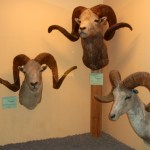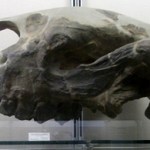mammalogy
In the previous article we looked at the majority of taxa included within the 'plecotin' group. As discussed therein, while there may be a clade of 'core plecotins', the traditional concept of the group might be paraphyletic. Some plecotins - Idionycteris in particular - might even be outside the clade that includes plecotins and all other vespertilionines. Here we look at a particularly interesting group of vesper bat species that might, or might not, be part of the 'core plecotin' clade: the desert long-eared bats (Otonycteris). What makes desert long-eared bats especially interesting is…
Yay, more vesper bats! The groups we've looked at so far have - in anatomical terms - been pretty conservative. This time round we're looking at a really remarkable group; as is so often the case, their familiarity (relative to so many others of the world's bats) means that we tend to forget or ignore how remarkable they are. Ordinarily, you might balk at the idea of a mammal whose ears are longer than the combined length of its head and body. Yet this is exactly what we have in the long-eared bats (or, in the Plecotus species at least). Yes, welcome to the world of... yeah, long-eared bats…
One of the largest and most successful vesper bat clades is Myotis, the little brown bats or mouse-eared bats. As you can see from the simplified cladogram shown right down at the bottom of this article, recent work indicates that they form the sister-taxon to the remaining vespertilionine vesper bats (for more discussion of their phylogenetic position, see the vesper bat cladogram article). Myotis occurs virtually worldwide in diverse habitats, contains about 100 species, and has been described as the most widespread mammalian genus after Homo* [composite below shows - clockwise from far…
Time to continue our trek across the vesper bat cladogram. In the previous article we looked at the bent-winged bats (or miniopterids, or miniopterines): a highly distinctive, morphologically novel group that seem to have diverged from vesper bats proper something like 45 million years ago. Their distinctive nature and long history of isolation relative to other lineages conventionally included within Vespertilionidae mean that bent-winged bats are now argued by many to be worthy of 'family' status. As we'll see here, they're no longer unique - bat workers now argue that another lineage of…
Welcome to part III of the vesper bat series though, as we'll see, the bats I'm covering here are not really vesper bat at all (anymore, and in the strictest sense of the term 'vesper bat'). They are the extremely strange, highly widespread long-winged bats, long-fingered bats or bent-winged bats (Miniopterus). Of these vernacular names, I prefer 'bent-winged bats'. As you can see from the simplified cladogram shown below, they're consistently found as the sister-group to virtually all other lineages conventionally included within Vespertilionidae [adjacent photo, from wikipedia, shows…
So, in the previous article we introduced vesper bats (sensu lato) as a whole, covered the idea that they're pretty diverse in morphology and behaviour, and also looked quickly at where they seem to fit within the bat family tree as a whole. As you'd predict for a diverse group of over 400 species, there have been numerous attempts to group these many species into clades, and to work out the patterns of evolution within the group. A large number of 'subfamilies' and 'tribes' have been named for different assemblages of vesper bat species, though a comparatively small number of useful…
Bats are one of those groups of animals that I've come back to on several separate occasions, yet have never dealt with in satisfactory fashion (that is, comprehensively). Seeing as the group includes over 1110 living species, I hope that this is forgivable. But I have plans, and over the last few weeks a number of coincidental and unrelated events have caused me to do a lot of thinking and writing about the enormous, hugely successful, globally distributed microbat group known as Vespertilionidae.
The bats in this group are variously known collectively as common bats, plain-faced bats,…
Reconstructions of the earliest phases of bird evolution - of 'near-birds' or 'protobirds', if you will - are pretty familiar, and hypothetical 'proto-pterosaurs' are also relatively familiar thanks to their appearance in the mainstream literature (Wellnhofer 1991, Unwin 2006). However, have you ever seen a reconstruction of a proto-bat? Such creatures must have existed, of course, but I'm only aware of one published effort to visualise them. Reproduced here, these reconstructions were originally published in Smith (1977) and were later reproduced in John Hill and James Smith's excellent…
I don't have time for anything at the moment, it's terrible. So here's this, from one of my talks on marine mammal diversity and evolution...
For more on Pezosiren portelli, see Domning (2001); the diagram contrasting the prorastomid, protosirenid and crown-sirenian is from Domning (2000). The Steller's sea cow painting is by Maurice Wilson. Sirenians were previous covered on Tet Zoo in When manatees crossed the Atlantic.
Refs - -
Domning, D. P. 2000. The readaptation of Eocene sirenians to life in water. Historical Biology 14, 115-119.
- . 2001. The earliest known fully quadrupedal…
Back in May 2007 I wrote a few articles about the world's wild sheep (Welcome.... to the world of sheep and Return.... to the world of sheep). If you're here for the dinosaurs, pterosaurs, pygmy mammoths and lake monster photos, you might regard wild sheep as pretty boring animals. But they're clearly not - they're incredible and spectacular in appearance, often surprisingly large, and they live wild lives in beautiful, wild locations. And they're highly popular, and the source of great fascination, among a great many people interested in animals - those 2007 articles have been good at…
Borrowed from here on David's Really Interesting Pages (and used with permission: thanks David). A sort of homage to this article from last month.
In terms of its zoological diversity, Europe is the best known continent on the planet. Indeed it's generally assumed that just about all of Europe's macrofauna has, by now, been discovered. While that's mostly true, it seems that at least a few species - so called 'cryptic species' - have been missed, mostly because they're extremely similar to their close relatives.
Here, I want to look briefly at new discoveries made concerning the diversity of European microbats [composite above shows, clockwise from top left: Pipistrellus pipistrellus, Plecotus auritus, Pl. austriacus and Myotis…
I really enjoyed the long and involved debate that followed my article on the small elephant depicted on the wall of Rekhmire's tomb. Thank you to (just about) everyone who contributed. As I tried to make clear in the actual article, we'll likely never know the truth of the matter, and this whole exercise should be seen as a bit of fun speculation [image below © Alessando Mangione and Marco Masseti].
Those of you who argued that the elephant could likely be stylized, or an inaccurate rendition of either an adult or juvenile Asian elephant Elephas maximus, could well be right. But, equally…
One of the things that came up in the many comments appended to the article on Bob's painting of extinct Maltese animals was the famous Egyptian tomb painting of the 'pygmy mammoth'. You're likely already familiar with this (now well known) case: here's the image, as it appears on the beautifully decorated tomb wall of Rekhmire, 'Governor of the Town' of Thebes, and vizier of Egypt during the reigns of Tuthmose III and Amenhotep II (c. 1479 to 1401 BCE) during the XVIII dynasty...
In 1994, Baruch Rosen published a brief article in Nature in which he drew attention to the small, tusked,…
It's well known that the islands of the Mediterranean were formerly home to an assortment of island endemics, all of which are now extinct. Most of the best known ones are mammals like pygmy elephants, pygmy hippos, pygmy megacerine deer and giant dormice, but there were also large birds, tortoises and lizards. My excellent friend Bob Nicholls of www.paleocreations.com has been kind enough to share this wonderful piece of art, featuring extinct and extant animals of Pleistocene Malta (close-ups below the fold). It's used with permission and is © Robert Nicholls.
One thing I particularly…
Whales are the most beautiful, perfect animals in the whole history of life. Shiny and flawless like pristine boiled eggs, they exist in perfect harmony with their environment, refuse to inflict needless suffering on other forms of life, and never suffer from disease or illness. Ha ha, just kidding! Check out these photos of a Bowhead Balaena mysticetus skeleton I encountered recently (IRSNB, Brussels). What can I say, other than "Ouch!".
This first photo shows the base of the whale's tail in left lateral view (the end of the tail is to the far right).
And here's the same region but seen…
People often send me links to stories of the Indian cow that took to eating baby chickens. The story isn't at all new: it appeared in the press in March 2007, and at least one of the cow's lapses into carnivory was filmed. It's shown here (though see below). As with the epic cat fight, do NOT watch this video if you are easily disturbed or upset by scenes of animal death and suffering. I will spoil the surprise by telling you that the cute little baby chicken gets eaten alive by the big nasty cow.
The cow concerned - named Lal - lives in Chandpur, West Bengal (though: the cow in this video…
The increasing availability of automatic cameras (cameras set up to take photos on their own are known in the trade as camera traps) has been a great boon to field biologists, and to people interested generally in the documentation of obscure and elusive creatures. Many animals hardly ever photographed in living state have been documented by these tools, and quite a few taxa never photographed in living state at all have been captured by them too. A few examples of the latter include Lowe's servaline genet Genetta servalina lowei (camera-trapped in 2002, shown at the top of the adjacent…
Back to the series on pouches, pockets and sacs (for previous articles see links below). The previous article finished by looking at the guttural pouches present in the Mongolian gazelle Procapra gutturosa. This links us nicely to the select group of mammals - perissodactyls, hyraxes, bats and rodents - that possess air-filled structures (called guttural pouches) located in the upper respiratory tract, pressed up close to the tympanic region at the back of the skull. In this article, I'm only going to deal with perissodactyls: the other groups can wait to later.
Guttural pouches are best…
When you discover something new on the internet, you usually find - minutes or hours later - that everyone else already knows about it, and you're just late to the party. And so it is here. But what the hell. Petya Cosmos recently alerted me to this hilarious, and interesting, video. The drama, the suspense, the sheer, epic scale of what unfolds, the music from Predator... make sure you have the volume turned up loud... [NB - only watch the video if you can have the sound on too].
Maybe it's just me, but I found the video hilarious (and brilliantly edited). Then again, I always did find cats…



















